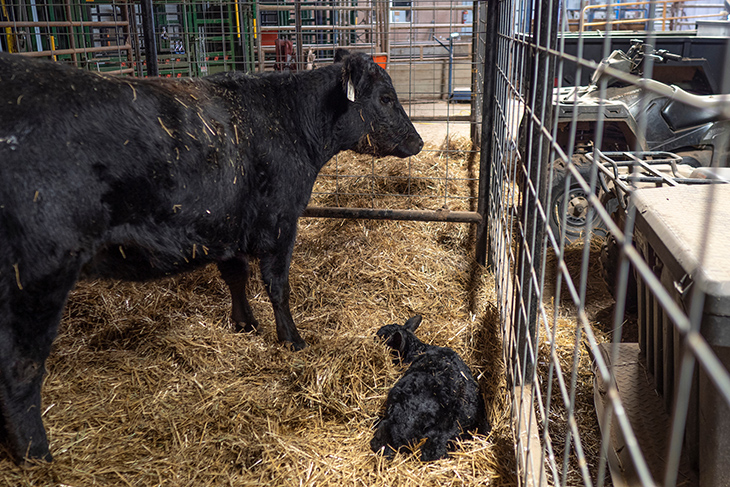
A backwards calf will need assistance at birth
Tuesday, March 16, 2021
Cow-calf producers should review how to help their livestock through a difficult calving beforehand, said Oklahoma State University experts. Most calves are born headfirst with their front feet extended, but a few are positioned backward and might not survive without help.
“A cow that is in early labor a long time or one that fails to progress to hard straining may be signaling that the calf is positioned wrong,” said Dr. Barry Whitworth, OSU Extension veterinarian and food animal quality and health specialist. “The issue must be corrected before the cow is in labor too long and the calf is dead.”
In a normal posterior position, the calf’s hind feet often protrude from the vulva. Occasionally, a frontward calf will be upside down or sideways with their legs twisted. An experienced individual should confirm the calf’s presentation before pulling.
Keys to helping with a backward calf include:
- Pull gently until the hips are free and the ribcage is safely through the cow's pelvis.
- Once hips are clear of the vulva, hurry the calf out, but not so quickly as to risk injury to the cow.
- Do not pull too forcefully because that potentially can crush a calf's ribcage.
If the calf is large, it may take more than one person or a mechanical puller to deliver the animal. Two average-size men is all the pressure that should be applied, Whitworth said. A mechanical puller can put a lot of traction on a calf so care must be taken not to pull too fast, especially when first easing the hips through.
Some backward calves might seem dead at birth, with glassy eyes and a blue tinge. Feel behind the front leg on the animal’s left side to check for a heartbeat. Stimulate coughing by sticking a clean piece of straw up one of the calf's nostrils. If the animal is unconscious, blue and will not cough, artificial respiration may be needed.
“Artificial respiration may keep the calf alive; put enough oxygen into its system to revive the animal,” said Dr. Rosslyn Biggs, OSU Extension veterinarian and director of continuing education for the university’s College of Veterinary Medicine. “Clear any mucus from the calf's nostrils, and lay the animal on its side with the head and neck outstretched.”
Hold the calf's mouth closed, cover one nostril and gently, but steadily, blow a full breath into the other nostril until the chest wall rises. Then, let the air escape on its own before blowing in another breath. Keep breathing for the calf until it can breathe for itself.
Recent OSU Extension workshops providing insight and practical tips about calving are available as an online video segment through the agricultural television show SUNUP. Fact sheets detailing research-based information about best calving management practices are available online and through OSU Extension county offices.
MEDIA CONTACT: Donald Stotts | Agricultural Communications Services | 405-744-4079 | donald.stotts@okstate.edu
